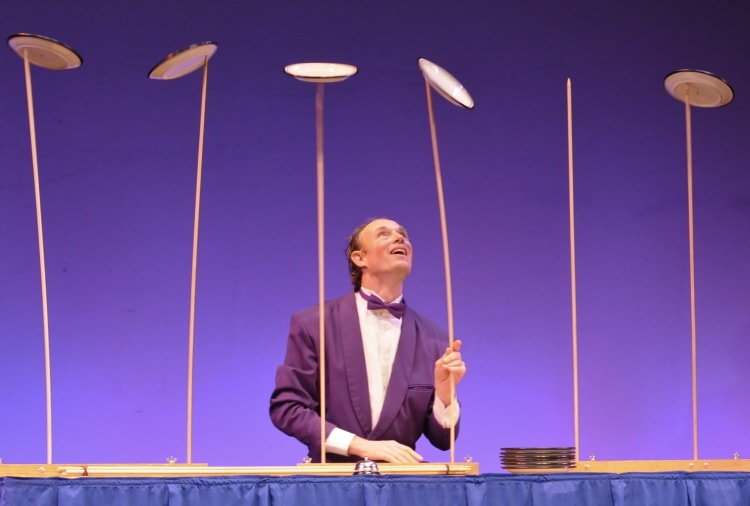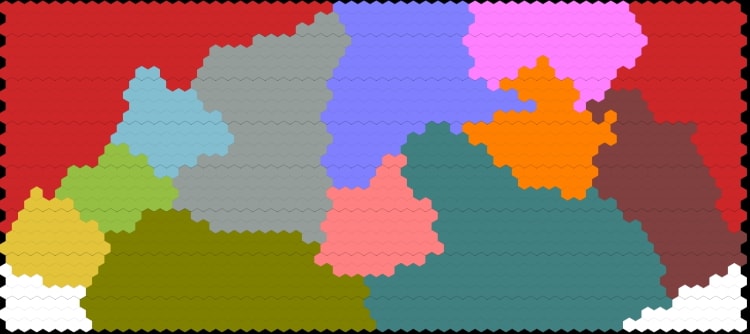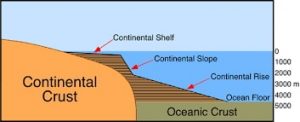
Welcome back to RedRaggedFiend.com. If you’ve been following along with the worldbuilding series you have your blank world map in hand. In the last post, Continents, we added some land to our blue ocean of a world. It looks great, but it lacks some crucial map elements. Wouldn’t you like to add some island chains, mountains, and volcanoes? Today, we’ll be using plate tectonics to add realistic map features that create map realism.
The aim here is to avoid a major map faux pas. I’m looking at you Mordor and your square mountain range.

Continent Overview & Worldbuilding Usefulness
As stated, the best thing we can get from this is realistic geological land forms. It will detail where active mountain ranges* appear on the map, including volcanic activity. This is important as mountain ranges have a huge impact on worldbuilding. Mountains tell us where rivers start, help determine biomes, and are a major influence on human geography. They are barriers that constrain travel, the spread of settlements, inform political boundaries, and shape trade routes.

*Smaller weathered mountain ranges are remnants of no longer existing plate boundaries. But, the most severe (longest and tallest) ranges sit at active plate boundaries. Which is what we’re focused on today.
We’ll also determine possible island archipelagos, rift valleys, and seismic hot spots. The last is important if you want to make natural disasters like earthquakes, volcanoes, and tsunami a part of your world. These are great for building your world history. Add Pompeii-style ruins and gigantic waves that wiped entire settlements off the face of the planet.
Tectonic Plates
The place to start is by determining how many plates make up the crust of the world. Plates come in two sizes: Major Plates and Minor Plates.
DISCLAIMER
Be warned, plate tectonics is a thing we only know a little about in regards to science. Turns out, it's difficult to determine what's happening under the Earth's surface. Of what we know it's quite complex. For this exercise we're dealing with the most basic concepts and interactions of plate tectonics.
Earth has seven major plates and many minor/sub plates. For our purposes seven is a good place to start. If you want to randomize the effects try rolling 3d4 to determine the number of major plates. Consider the below effects when considering how many major plates you want.
More Plates
The world will have more, but less severe plate boundaries. That means shorter plate boundaries with less severe effects. More frequent, less intense, earthquakes, smaller mountain ranges, and island arcs (height and length).
Fewer Plates
The world will have fewer, longer, and more severe plate boundaries. Deeper rifts, taller and longer mountains/island arcs. Rare, but higher magnitude earthquakes.
Plate Sizes
If you’ve been working on a map with this series you should have a 60 x 30 world map totaling 540 hexes. Take 20% of the hexes as a reserve for your minor plates. Divide the remaining 80% (432 hexes) between your major plates. You can freehand direct to the map by building off the map’s continents or determine the plate sizes independently. If free-handing, skip down to Plate Placement. If you choose the latter try Zipf’s Law to distribute the hexes.
432 Hexes = X + 1/2X + 1/3X + 1/4X + ... Continue series until you have accounted for each major plate.
Make sure the minor plates you create afterwards are smaller than the smallest major plate.
Plate Placement
Step One
Find a strong starting boundary. Refer to Earth’s Marianas Trench as an example of a strong starting boundary. You might also consider the West Coast of the Americas, which feature a near constant N/S line of mountain ranges.
Step Two
Consider a polar plate for two reasons. First, Earth has one and the closer we model Earth the easier time we’ll have worldbuilding. Second, a polar plate keeps the map from having interesting landforms where they won’t impact people.
Step Three
Most continents occur on a single plate. Reference the continents when placing plates to avoid fracturing continents over major plates.
Step Four
Don’t conform major plates fully flush against each other. Leave spaces to intersperse minor plates. And remember to keep those minor plates smaller than the smallest major plate.
Your final product might look something like my map below, built using Hextml.

Add Plate Movement
The world map should have your continents, major plates, and minor plates detailed. Now it’s time to add movement to the major plates. Find your starting point and assign movement to the bordering major plates. The easiest way to do this is to draw a few arrows along the border of each major plate. If you went with the Marianas Trench example, major plates should be moving towards the boundary.
It’s important to remember that plates only move in one direction; they never spread outward or shrink inward. There is no wrong direction to move your plate, but if you want a specific landform check Plate Boundary Types below.
Major plates act on minor plates like tectonic bullies. Look at each minor plate and see how the major plates inform its movement. The largest and most direct major plate acting on it will force the minor plate in that direction. Minor plates interact with other minor plates as usual.
Continental & Oceanic Plates

There are two types of plates, continental and oceanic. Oceanic plates are more dense than continental plates. Because it’s more dense an oceanic plate will subduct (slide under) a continental plate. Which means tectonic landforms happen on the continental side of a plate boundary. Mountains, volcanoes, island archipelagos all happen on the continental side. That’s the reason many island arcs and mountain ranges occur close to the coast.
Plate Boundary Types
There are three plate boundary types: convergent, divergent, and transform.
Convergent
Convergent boundaries happen when one plate runs into another. This could mean they hit head on, one hits the other from behind because it’s moving faster in the same direction. Or one plate could slam into the side of another plate. Think of convergent boundaries like automobile collisions. It could be a head-on, rear-end collision, or T-bone collision. And, like a car collision the impact causes the plates to buckle. This creates mountain ranges, deep sea trenches, and island archipelagos*. Most convergent boundaries also feature volcanic activity.
*Mid-oceanic plate island archipelagos are created by hot spots and plate movement. Right now we’re looking at examples like Japan, not Hawaii.

DID YOU KNOW?
The difference between mountain ranges and island arcs is the ocean. Think of Japan as the top segment of an underwater mountain range. Just like Water World.
Divergent
As you might guess from the name divergent boundaries happen when plates separate. Two plates could be moving away from each other. They could be moving in the same direction but, unlike the previous rear-end collision example, the leading plate moves faster creating separation. And one plate could me separating from the side of a plate moving perpendicular. When plates diverge they create rifts. In the ocean the boundaries create seafloor spreading ridges. On land it creates rift valleys like those in Iceland and East Africa.
Transform
If plates aren’t colliding or separating they’re grinding across each other. That’s a transform boundary. Transform boundaries are best known for creating seismic energy and splitting land forms. Seismic energy is when the plates expend built-up pressure by moving. Most often it seismic energy occurs as earthquakes and tsunami. The latter being the consequence of earthquakes happening out in the ocean. Split land forms is an effect of transform boundaries. Transform boundaries can split roads, hills, settlements, even rivers. This happens by the boundary shifting along the x or z axis.

Assign Plate Boundaries
Make sure to cross reference your continent map with your plate map. You should note new mountain ranges, rift valleys, and possible island arcs*. There’s no physical land form to note at transform boundaries, but you’ll want to keep it in mind for worldbuilding.
*Because the ocean is deep, many underwater mountain ranges don’t break the surface and so aren’t island arcs. An underwater convergent boundary is no guarantee of an island arc.
On my personal maps I translate dark blue tiles (deep ocean) tiles to light blue at convergent boundaries. I also do the reverse, translating light blue tiles (continental coast) to dark blue at divergent boundaries. This helps me to remember to increase the chance for islands at convergent boundaries and decrease the chance for islands at divergent boundaries.
Plate Tectonics Conclusion
Congratulations, that’s it for plate tectonics. A pretty painless process. At this end of this segment your blank world map should have some new deep/shallow ocean tiles, mountain ranges, and rift valleys. You should also seismic hot zones for later worldbuilding.
Thank you for reading and letting me share my worldbuilding process with you. If you’d like to more check out my PWYW downloads on DriveThruRPG. Or help me stay awake and buy a Ko-Fi.
If you’re like me you’re chomping at the bit to dig into the map making fun stuff, BIOMES! Next time we’ll take the first step in that direction, we’ll add wind and water systems to the world. The last puzzle piece we need before adding green to the world map.
Recommended Reading
Do you have a personal reference library? Serious DM/GMs accrue useful books over time as reference material. And while RPG books are important I recommend adding a middle school/high school Earth Science textbook to your library. It provides fundamentals about the planet with many useful graphs, charts, and illustrations.

Pingback: RPG Player Levels & How to Increase Your Level | Red Ragged Fiend